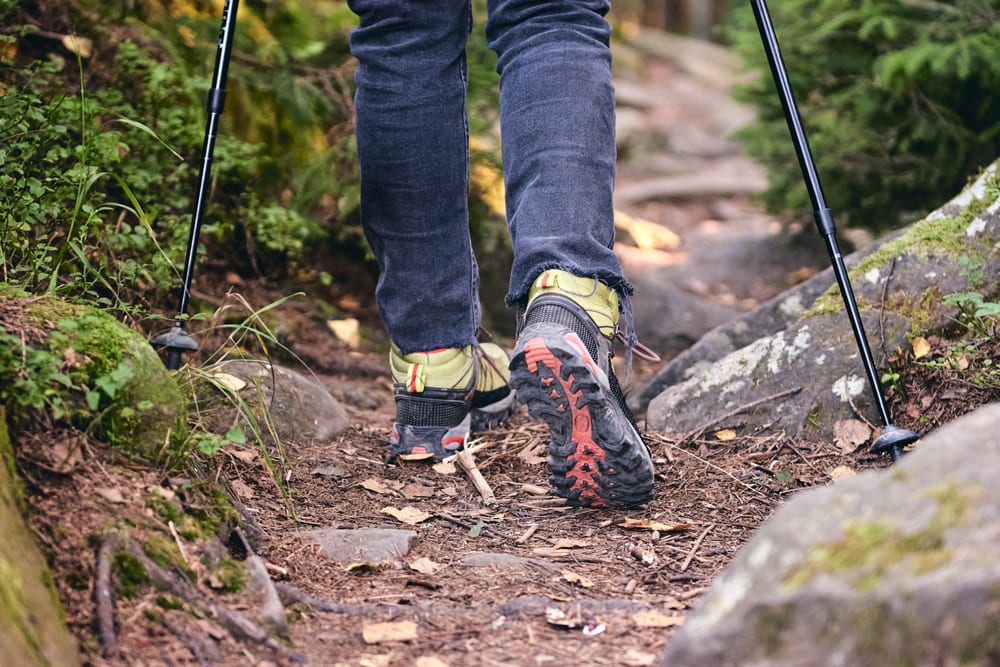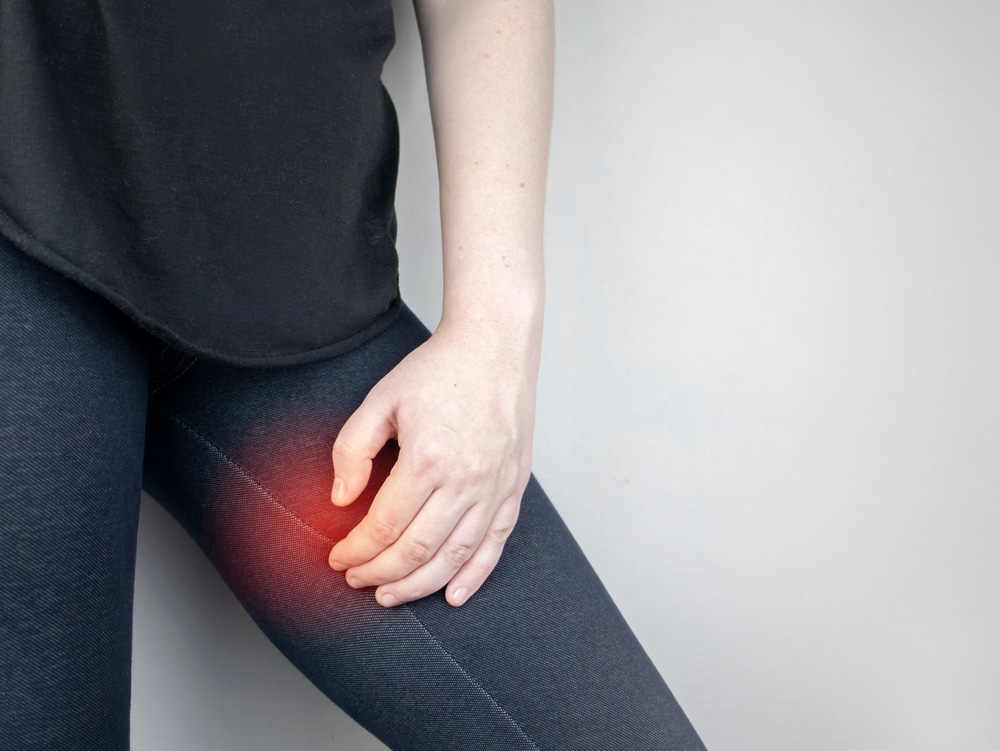Outforia QuickTake: Key Takeaways
- Jeans can be suitable for hiking in specific conditions such as dry weather, short hikes, and areas with thorny scrubland due to their durability and resistance against wear and tear.
- However, jeans are not recommended for long-distance, wet, and freezing weather hikes as they get heavy when wet, lead to chafing, do not dry easily, and provide insufficient insulation in cold conditions.
- Depending on the weather conditions, hike length, terrain, and season, different types of hiking pants should be used, which include convertible pants, standard hiking pants, softshell pants, and hardshell pants.
- Most hiking pants are made from a combination of synthetics or synthetics mixed with natural fibers such as nylon, softshell, polycotton, hemp, and wool. The choice of material depends on the weather conditions and comfort considerations.
- Tips for hiking in rainy weather include avoiding slippery areas, eating on-the-go snacks, and opting for synthetic fabrics with ventilation instead of cotton or denim clothing.

Whether to wear jeans on a hike depends on your hike’s duration and the weather conditions. The type of terrain can also play a part.
Jeans were first developed as workwear. They were developed in 1890 by Levi Strauss for activities such as gold mining.
They have now become streetwear and casual wear. They’re comfortable, right? So why can’t we use them for exercise such as hiking too?
The issue is in the type of exercise you’re doing. Jeans resist wear and tear. They resist dirt too, which is brilliant if you are a miner.
However, if you are hiking a long distance in the rain, wet denim can chafe in the most awkward of places, get heavy and cold, and even freeze onto your body.
So, what should we wear on our bottom half on a hike?
When to Wear Jeans on a Hike

There are some circumstances where hiking in jeans is comfortable, or even preferable. These conditions are: thorny scrubland, dry weather, and day hikes.
In some areas of the earth, there are viciously spiny bushes that can tear your unprotected calves to shreds. A good example of this is the cattle ranches of Texas, which is part of the reason cowboys have become iconic jeans wearers.
The Australian Outback is another place where hot, dry conditions and thorny plants combine.
Jeans are cool in hot, dry weather because they are made of cotton. The dense weave will protect your body from UV rays.
On short hikes, there’s not so much chance of jean chafing becoming a problem. By the time you’ve started to get uncomfortable, you’re back home. You may still want to avoid this possibility and use hiking pants instead.
When to Not Wear Jeans on a Hike

Jeans can prove to be a clothing disaster in the following hiking conditions: wet weather, freezing weather, and long-distance multi-day hikes.
Jeans are not ideal for wet-weather hiking
In the rain, jeans will rapidly get waterlogged. This makes them much heavier and harder to hike in.
Jeans take ages to dry out compared to specialty hiking pants. If it then gets cold, the wet jeans will lose your body heat quickly.
Chafing can easily happen in wet conditions. Denim is rough, and wet denim seams can abrade your skin. This tends to happen in tender places like your crotch or waist. Ouch!
Jeans are not ideal for freezing weather
In sub-zero conditions, the breathability of denim can backfire. Snow, ice, or sleet that falls on your jeans will melt from your body heat, which the jeans have failed to insulate.
The snow then melts and makes your jeans wet. This will then make you very cold. Plus, the jeans freeze once they are away from your body.
All this can be, at best, uncomfortable and, at worst, life-threatening. Sub-zero conditions are not to be trifled with. So leave your jeans for warmer, drier weather.
Jeans are not ideal for long-distance hikes
Long multi-day hikes or backpacking trips are not the best environment for jeans. The continuous walking over long periods causes a lot of sweat, which will make your jeans damp and cause chafing.
Once chafing starts, it gets much worse very quickly. A long hike in this state is miserable. Make sure you have another pair of pants in a softer, more weatherproof material to change into!
Jeans are much heavier than hiking pants, too. This extra weight can add up on a long hike, especially if the jeans get wet.
Here’s a quick infographic to sum it all up

Share this image on your site
<a href="https://outforia.com/hiking-in-jeans/"><img style="width:100%;" src="https://outforia.com/wp-content/uploads/2023/09/hiking-in-jeans-pros-and-cons-0923-683x1024.jpg"></a><br>Hiking in jeans pros and cons by <a href="https://outforia.com">Outforia</a>You may also like: Walking With Nature: A Guide To 20 Different Types Of Hiking
What To Look For in Hiking Pants

Assuming you’re wearing hiking pants and not jeans, consider these factors when choosing your hiking pants:
- Weather conditions: rainy, windy, or hot and dry?
- Length of hike: day hike or week-long trek/backpacking?
- Terrain: thorny scrub or steep, rocky mountain?
- Season: winter, summer, or a season of mixed weather like autumn?
The material your hiking pants are made of is a big factor in your decision. Later on in this article, we’ll be looking at the types of materials available for hiking pants.
Types of Hiking Pants

There are four types of hiking pants you can use. They’re all made for different conditions. So which is which?
- Convertible pants
- Standard hiking pants
- Softshell pants
- Hardshell pants
Convertible pants

Convertible pants have zips, which you use to turn them from shorts to pants. This is great for trails that have a steep gradient where the weather and temperature will change rapidly.
You can put the pants legs back on if there are lots of biting insects like mosquitoes and ticks around. You can add them back on if the underbrush gets thorny.
Standard hiking pants

Standard hiking pants don’t have the zip-off convertible function, but they do have gusseted crotches, drawstring bottoms, articulated knees, and plenty of roomy zippered pockets.
These make them more comfortable for exercising than jeans or other trousers you would wear around town.
Softshell pants

Softshell pants are made of more durable fabric, despite their name. They are made for more challenging conditions, such as mountaineering.
They are more resistant to wind, water, and abrasion. They are most often a mixture of nylon, polyester, and elastane. They are a good choice for three-season weather conditions, where the weather can range from hot and sunny to fairly cold.
Softshell pants are breathable and allow moisture to wick away from your body.
Hardshell pants

Hardshell pants are your go-to pants if the weather suddenly becomes very foul. Hardshell pants also go by the name of rain pants.
Keep a pair in your pack for adverse conditions. Hards
Take them off as soon as the weather clears up; otherwise, you will sweat in them and get almost as wet as if you hadn’t had them on.
If you are on a technical climb, roped in a harness with crampons on, full-zip hardshell pants are essential. It’s very hard to get half-zip or ¾ zip pants on in this situation, where you can’t take your boots off.
You may also like: How To Waterproof A Backpack: 4 Ways And Tips For Keeping Hiking Gear Dry And Clean
Best Material for Hiking Pants

Most hiking pants are made from a combination of synthetics or synthetics mixed with natural fibers. Synthetic materials are quick-drying, stretchy, and comfortable.
Many pure natural fabrics hold water, making you cold. That doesn’t mean you should avoid natural fabrics entirely.
Natural fibers are breathable and comfortable in hot weather. A lot depends on the season and the conditions. Have a look at the choices below and take your pick.
- Nylon
- Softshell
- Polycotton
- Hemp
- Wool
Wet Weather Hiking Tips

Here are some tips about how to stay comfortable on a rainy trail. No one sets out to go hiking in the rain, but it happens mid-trail.
The most beautiful places seem to always be the ones with the most rain. So it’s best to be prepared, as the weather can change rapidly.
- Stay off slippery summit walks. You’ll be disappointed if you can’t see the view you hoped for anyway. Instead, try hiking in the woods or on a lowland trail. Be careful of river flooding, though.
- Take snacks you can eat on the go. You don’t want to stop and get cold while you make a sandwich.
- Avoid cotton or denim.
- Choose synthetic fabrics with ventilation.
- Put your dry things (like a change of socks) into a plastic carrier bag.
- Check whether your clothing is water-resistant or completely waterproof.
What is Chafing?

Chafing is when your skin is irritated or damaged by rubbing against another part of your skin or clothing.
The affected parts become pink-red and raw-looking. It happens a lot when taking part in sports or traveling long distances on foot, by bike, or on horseback.
You may also like: 7 Must-Know Hiking Trail Signs
FAQs

Are jeans good for hiking?
Jeans are not the best choice for hiking. But if you’re going for a short hike in sunny weather, jeans can be perfectly adequate.
If you’re heading through thorny underbrush, jeans can even be a good choice. If you’re hiking for several weeks during rainy or cold weather, wearing jeans could even be dangerous.
Are jeans or sweatpants warmer?
This depends on what they are made of. Traditional denim jeans don’t insulate well. Jeans made of wool will, however. Sweatpants made of cotton will not be as warm as sweatpants made of wool or fleece.
What hiking pants are most breathable?
Hiking pants with the most polyester are generally the most breathable.
What hiking pants are the most durable?
Nylon-based hiking pants are the most durable. Look for pants with a high percentage of nylon. It’s a good idea to have some elastane (Spandex) in there to add stretch for a good fit.








